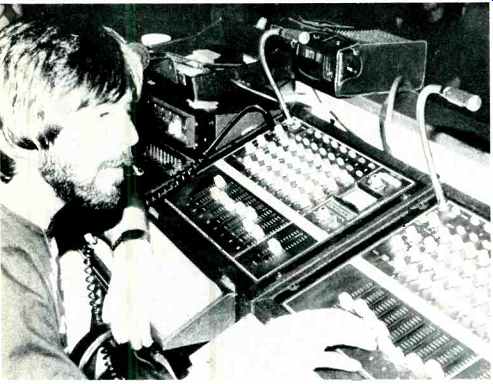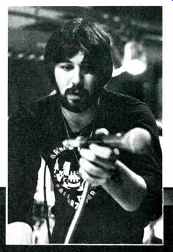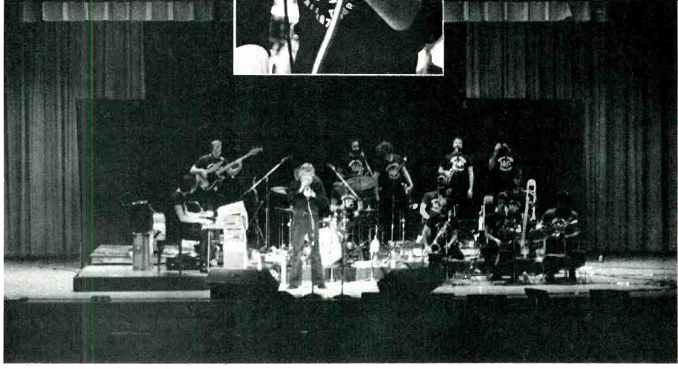Interview with Maynard Ferguson's sound man.
When asked about getting material for a story on the experiences of a sound technician, I had an immediate interest. That was heightened by the fact that Tony Romano, the subject of this article, was doing sound for the Maynard Ferguson Orchestra. I hadn't heard Maynard play in quite some time, and I looked forward to getting my ears brought up to date.
The interview with Tony was directed with the end purpose of gaining an understanding of his particular job, and how his particular experience might benefit our readers who "do sound." Band personnel included Maynard Ferguson, of course, a versatile performer on trumpet, flugelhorn and other brass, including the superbone, a combination slide and valve trombone. On trumpet were Stan Mark, Dennis Noday, Ron Tooley, and Loon Mosello, who also doubles on congas. Randy Purcell and Roger Homefield play trombones, and Mike Migliore, Bobby Militello, and Mark Colby are on saxes. Gordon Johnson plays bass, Biff Hannon keyboard, and Peter Erskine ties it together on drums.
The orchestra played a program of considerable variety to match the wide age span of the audience, from very young to middle aged. The program included numbers from current Columbia record releases.
The typical one-nighter demands a lot from all of the personnel, and from the time they arrive at the concert site every minute is important. Almost before the bus stopped rolling in front of the Somerset ( Mass.) high school, local students were aiding in the transfer of instruments and equipment to the stage of the auditorium. Advance arrangements had been made for the positioning of risers for the band and hanging of lighting from some fly rails. Then ensued the set-up of equipment and instruments, adjustments of lighting, etc., through the cooperative efforts of the Ferguson group and the local school personnel.
Romano ran a snake to the booth at the back of the auditorium where he had placed his control equipment.
After he had completed connections and the final check-out, we had a short time to talk before the concert.
Tony Romano has been with Maynard since September 1975 and spends about 40 weeks per year on the road.
He is 24 years old and still calls Buffalo, N.Y., his home. When he was 16 years old, he played guitar in various bands. After high school he attended more pop and jazz concerts, developing his own concepts on what the sound should be and how he would do the job. He played both acoustic and electric guitar with The New Wave, a jazz sextet, for two years. He found, however, that he was doing more sound and less playing, and at one time he was the sound technician at Mulligan's Night Club in Buffalo.
Although Tony had a musician's background, he did take a number of electronics courses at the University of Buffalo. His education degree in history prepared him to be a teacher, but his involvement in sound and music had increased during college years, lessening the desire to teach.
Tony had done studio work in Buffalo, and was hired directly to be the sound technician for the touring Maynard Ferguson Orchestra.
Tony Romano uses many close-up mikes for the Manyard Ferguson band to avoid losing the weaker instruments.
Sound Background
I asked Tony for some thoughts on what sort of experience would be
helpful to those hoping to become sound technicians. His music background was an obvious aid to him. He suggested that a lot can be done in the home with a good tape deck. "There are a variety of things you can do pretty much on your own. Start fairly simply with such things as a four-channel mixer and a few microphones, borrowing as you can. Experiment with microphone placement (and types, if you can) with various instruments.
Keep working at it as it takes a long time to gain expertise, particularly for the challenging situation such as doing sound in an over-live gym."
The particular approach that Tony regularly takes with his tasks with the Ferguson band can be applied where any sound man is working with the same group and needs to keep set-up time to a minimum. "First of all, the band should have personnel in the same position at each performance.
Make a standard practice of miking close, each and every source of sound you may want someone to hear. If you have been using mikes at some distance, perhaps picking up more than one instrument, you could very well find that you cannot operate such a set-up at a location where it is much more reverberant. Another advantage of miking close is that you can fill in any holes that might appear during the performance, as soon as they are detected."
Tony has all of his stage mike cables to exact length in what could be called mini-snakes. This scheme saves a great deal of set-up time, and mistakes are eliminated in the connections, with clues both from the length and attached labels. The system also speeds up break down, important in a situation such as Tony's, where there is just one sound technician, and other people have their jobs to do. Another advantage of the standard set-up with exact lengths and labels is that, in case of emergency, someone else could make the necessary connections with a minimum of confusion.

----Romano at work with the Shure M67 Mixer and the M610 Feedback Controller
to get a proper acoustic balance in the auditorium.
Sonic Standardization
The equipment was pretty much Shure throughout, including mikes and SR amps, speakers, and boards. The stage monitors for the two solo mikes were two small Vocalmaster speakers, and control was provided by a Shure M67 mixer, used in conjunction with a M610 Feedback Controller.
The only signal processing was provided by an MXR auto phaser used with a separate drum mixer and the occasional use of a Maestro Echoplex.
Tony stated that he preferred the sound for inside locations without compression or limiting, and that effects should be subtle and used with discretion, not all the time. Everything, band personnel and equipment, has to fit on one bus, placing a limit on how much gear can be carried on their series of one-nighters. It was apparent that advance planning and communication with Somerset school personnel had ensured the efficient setting up I observed.
Tony felt that the challenge of working inside locations was trying to make the audience appreciate the music in its purest form. "The attempt should not be made to generate very high sound levels, only what is necessary for the music. The basic show is a mono feed which works well in most cases, plus the fact that stereo reinforcement is touchy and it is difficult to get good sound except for people in the center. It is possible to do good stereo sound in a club that has an installed, well engineered system, including locations for seating. Sound reinforcement for Ferguson is biamped most of the time, with infrequent tri-amping for that 'something extra.' Inside, the sound man must deal with the acoustics of the room, while outside there is substantially no liveness. For the outdoor scene, there is much more dependence on the amplifier /speaker system, and how good it is. When the Ferguson orchestra is going to do an outdoor festival, advance contact is made to make certain that there is a good sound system installed at the performance site. I do prefer to use my own boards and mikes which I have been using day-in and day-out."
Traveling Diplomacy
When we discussed the personality needs for a job such as his, Tony pointed out that throwing orders at local people was a bad approach and that everything went much smoother when good communication is established right at the start. "The sound man must be personable to get things done, and it helps to make the concert what it should be, fun. There are bound to be frustrations, but keep your patience in any case. Coming into a new town with new people, you have to make the effort to keep cool. For them it's a new experience; they don't know what happened the night before or on the trip that might have you on edge. You want to keep this in mind, make their experience a pleasurable one. Bring along a friendly attitude, and treat them with respect. Then, things just get done, they fall into place.
"Its good to have our personnel in consistent dress, such as our Maynard Ferguson T-shirts, to aid in immediate identification when we arrive. From an appearance standpoint, it makes sense to dress nicely, no jeans, but clothes have to be able to take the wear and tear of set-up and break-down. The orchestra does not try to put on a stage act with any form of costume, and the kimonos they wear in the second half of the program were picked up on our tour in Japan, where in 16 days we gave concerts in 14 cities."
Tony agreed that good health is required for a job such as his, with some extra energy needed for the collection of one-nighters. "We'll be packing up tonight to head off for New York City, getting there about 4 or 5 in the morning. Many think that the road life is lots of fun, but it's very demanding. Others believe that there is a lot of glamour and a lot of time for getting kicks, but there is little chance to do extra things when on the road. The band has had a full schedule with relatively few open nights, and usually they were needed for travel."
So much for the philosophy, how about the results? There hadn't been time for a sound check before the concert, but Romano touched up the balances very quickly in the first number without any detectable miscues. The brass needed very little reinforcement in the fairly live auditorium, and the individual, close miking permitted getting a good solid sound without loss of any of the low-level instruments. Tony obviously enjoyed the music itself and was continually attentive to the sound, even though he must have heard the tunes many times before. The program was filled with consistently good performances, but Pagliacci from the recent Columbia record, Primal Scream, certainly was a highlight. Bobby Militello gave what must be classified as a virtuoso performance on flute, and Tony added effects with the use of the Echoplex. It would have been possible, of course, to have such a device on all the time, but its use for special effects only generated an excitement that would not have occurred with "echo overkill." The setting of delay and level was very effectively done, greatly adding to and enhancing the talented performance of Militello. I don't think that most of the audience knew how it all came about, but there was no doubt about their excitement and pleasure from such a musical experience.
I made some notes on my impressions of the performance of the last numbers, including the standing ovation encore. At the end where many groups tend to start goofing off, the band was still "disciplined, spirited, exuberant, and precise with good attacks." For me it was one of the most exciting evenings of music in quite some time, and I thank Maynard Ferguson, his orchestra, and Tony Romano, their sound technician, for that. The emphasis that they all put on satisfying the audience and working cooperatively with local people is one that should be taken to heart by all bands and their sound technicians.
(Source: Audio magazine, Nov. 1977; Howard A. Roberson)
Also see: Matching a Mike (Aug. 1986)
= = = =

